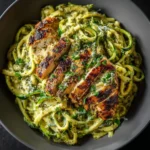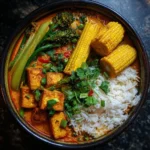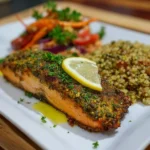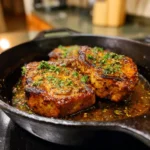Vegan Thai Red Curry with Tofu & Baby Corn
Indulge in the vibrant, aromatic world of Southeast Asian cuisine with this luscious Vegan Thai Red Curry featuring tender tofu and crisp baby corn. This plant-based rendition of a beloved classic captures the perfect balance of spicy, sweet, savory, and creamy textures that define authentic Thai red curry—without any animal products. Whether you’re a committed vegan or simply exploring meatless meals, this dish delivers bold flavors and satisfying nourishment in every bite. From its rich cultural roots to its customizable variations, this recipe is both a celebration of tradition and a canvas for modern culinary creativity.
The History
Thai cuisine has long been celebrated for its intricate layering of flavors—spicy, sour, salty, sweet, and umami—all harmonized in a single dish. Thai red curry, known as “Gaeng Phed” in Thai, originated in Central Thailand and has been a staple in Thai households for generations. The term “red” comes from the deep crimson hue of the curry paste, derived primarily from dried red chilies. Traditionally, Thai red curry was made with meat or seafood simmered in coconut milk with aromatic herbs and spices.
Over time, as vegetarianism and veganism gained popularity globally—and particularly within Buddhist communities in Thailand—plant-based versions began emerging. Tofu, long used in Thai Buddhist temple cuisine, became a natural protein substitute. Ingredients like baby corn, bamboo shoots, and eggplant were incorporated not only for texture but also because they complement the creamy richness of coconut milk. Today, vegan adaptations of Thai red curry are widely embraced, both in Thailand and abroad, reflecting a growing awareness of health, sustainability, and ethical eating without sacrificing flavor or authenticity.
Ingredients Breakdown
Understanding each ingredient in this Vegan Thai Red Curry helps elevate your cooking experience and ensures optimal flavor, texture, and nutrition. Here’s a detailed breakdown:
- Firm or Extra-Firm Tofu: The star protein source. Firm tofu holds its shape well during cooking and absorbs the curry’s flavors beautifully. Pressing the tofu before use removes excess water, allowing it to crisp up when pan-fried and soak in more sauce.
- Red Curry Paste (Vegan): The soul of the dish. Traditional red curry paste contains shrimp paste, so be sure to use a certified vegan version. Look for brands that list ingredients like dried red chilies, lemongrass, galangal, kaffir lime peel, garlic, shallots, and salt—no fish or shrimp derivatives.
- Coconut Milk (Full-Fat): Provides the creamy base and balances the heat. Full-fat coconut milk gives the richest texture and mouthfeel. Shake the can well before opening to blend the cream and liquid evenly.
- Baby Corn: Adds sweetness and a delightful crunch. Canned baby corn is convenient and works perfectly here; just rinse and drain before adding. Fresh baby corn can be used if available.
- Vegetables (Optional Add-Ins): Common additions include bell peppers, zucchini, broccoli, mushrooms, or Thai eggplant. These enhance color, texture, and nutrient density.
- Lemongrass (Fresh or Paste): Imparts a bright, citrusy aroma. If using fresh, bruise the stalk by lightly smashing it with the back of a knife to release essential oils, then slice finely or remove before serving.
- Kaffir Lime Leaves: A quintessential Thai ingredient with a floral, citrus fragrance. Tear the leaves slightly before adding to release their essence. Remove before eating, as they are not meant to be chewed.
- Soy Sauce or Tamari (Gluten-Free Option): Adds saltiness and depth. Tamari is a smoother, gluten-free alternative to soy sauce, ideal for those with sensitivities.
- Maple Syrup or Coconut Sugar: Balances the spice and acidity. A small amount enhances the natural sweetness of the coconut milk and vegetables without making the dish taste sugary.
- Lime Juice: Added at the end for a zesty kick that brightens the entire dish.
- Vegetable Oil: For sautéing the curry paste and tofu. Use a neutral oil like canola, sunflower, or refined coconut oil.
- Fresh Herbs (Cilantro, Thai Basil): Used as garnish. Thai basil has a licorice-like flavor that’s more authentic than sweet basil. Cilantro adds freshness.
- Cooked Jasmine Rice or Rice Noodles: The traditional accompaniment. Jasmine rice’s floral aroma pairs perfectly with the curry’s complexity.
Step-by-Step Recipe
- Press the Tofu: Begin by draining the tofu block. Wrap it in a clean kitchen towel or paper towels, place it on a plate, and put a heavy object (like a skillet or books) on top. Let it press for 15–30 minutes to remove excess moisture. This step ensures better browning and flavor absorption.
- Cut and Pan-Fry the Tofu: Once pressed, cut the tofu into 1-inch cubes. Heat 1 tablespoon of oil in a large non-stick skillet or wok over medium-high heat. Add tofu in batches and cook until golden brown on all sides, about 6–8 minutes total. Remove and set aside.
- Sauté the Curry Paste: In the same pan, add another tablespoon of oil. Add 3–4 tablespoons of vegan red curry paste (adjust to taste) and stir constantly for 1–2 minutes until fragrant. This step “blooms” the spices and intensifies the flavor.
- Add Aromatics: Stir in 1 tablespoon of minced lemongrass (or ½ tsp lemongrass paste) and 2 torn kaffir lime leaves. Cook for another 30 seconds to release their essential oils.
- Pour in Coconut Milk: Slowly pour in 1 can (400 ml) of full-fat coconut milk while stirring. Bring to a gentle simmer, whisking occasionally to blend the curry paste thoroughly into the milk.
- Add Seasonings: Stir in 2 tablespoons of soy sauce or tamari, 1 teaspoon of maple syrup or coconut sugar, and a pinch of black pepper. Taste and adjust for saltiness, sweetness, and spice.
- Add Vegetables and Tofu: Add 1 cup of rinsed baby corn, along with any other vegetables you’re using (e.g., sliced bell peppers, mushrooms). Return the fried tofu to the pan. Simmer gently for 8–10 minutes, allowing the flavors to meld and the vegetables to become tender-crisp.
- Finish with Freshness: Turn off the heat. Stir in 1–2 tablespoons of fresh lime juice. Remove kaffir lime leaves and any large lemongrass pieces if used.
- Garnish and Serve: Ladle the curry over steamed jasmine rice or rice noodles. Top with fresh Thai basil leaves, cilantro, and optional red chili slices for extra heat. A wedge of lime on the side enhances brightness with each bite.
Tips
- Don’t Skip Pressing the Tofu: This simple step makes a huge difference in texture and flavor absorption. For even crispier tofu, toss the cubes in 1 tablespoon of cornstarch before frying.
- Bloom the Curry Paste: Sautéing the paste in oil unlocks deeper, more complex flavors than simply mixing it into cold coconut milk.
- Use Full-Fat Coconut Milk: Light coconut milk will result in a thinner, less creamy curry. For extra richness, reserve the thick cream from the top of the can to stir in at the end.
- Adjust Spice Level Carefully: Start with 2 tablespoons of curry paste and add more after tasting. You can always increase the heat, but you can’t reduce it.
- Add Delicate Veggies Later: If using spinach, snow peas, or bean sprouts, add them in the last 2 minutes of cooking to preserve their color and crunch.
- Make It Ahead: This curry tastes even better the next day as the flavors continue to develop. Reheat gently on the stove, adding a splash of water or coconut milk if needed.
- Freeze for Later: Store in an airtight container and freeze for up to 3 months. Thaw overnight in the fridge before reheating.
Variations and Customizations
This Vegan Thai Red Curry is highly adaptable to suit different tastes, dietary needs, and seasonal ingredients. Here are some delicious variations:
- Protein Swaps: Replace tofu with tempeh, seitan, chickpeas, or lentils. For a soy-free option, use jackfruit or edamame.
- Vegetable Variations: Swap baby corn with bamboo shoots, green beans, carrots, bok choy, or sweet potatoes. Roasted squash adds a lovely sweetness.
- Curry Base Twists: Try yellow curry paste for a milder, turmeric-rich version, or green curry paste for a fresher, spicier profile.
- Coconut-Free Version: For those avoiding coconut, use cashew cream or blended silken tofu with vegetable broth as a creamy base (though it won’t be traditional).
- Noodle Curry: Turn it into a curry noodle bowl by adding cooked rice noodles directly into the sauce for a pad ka pao-style dish.
- Spice It Up: Add fresh red chilies, chili oil, or sriracha for extra heat. Or serve with sliced bird’s eye chilies on the side for adventurous eaters.
- Herb Infusions: Experiment with mint, regular basil, or Vietnamese coriander (rau răm) for unique herbal notes.
- Gluten-Free Option: Ensure your soy sauce is gluten-free (tamari), and verify that your curry paste is GF-certified.
Health Considerations and Nutritional Value
This Vegan Thai Red Curry isn’t just flavorful—it’s also packed with nutrients that support overall wellness. Here’s what makes it a healthy choice:
- Heart-Healthy Fats: Coconut milk contains medium-chain triglycerides (MCTs), which may support metabolism and energy levels. While high in saturated fat, recent studies suggest that coconut-derived fats may have a neutral or beneficial effect on cholesterol when consumed in moderation as part of a balanced diet.
- Plant-Based Protein: Tofu is a complete protein, meaning it contains all nine essential amino acids. It’s also rich in calcium, iron, and magnesium, especially when made with calcium sulfate.
- Low in Cholesterol and Saturated Fat (Compared to Animal Versions): Unlike traditional meat-based curries, this vegan version eliminates dietary cholesterol and reduces saturated fat intake, supporting cardiovascular health.
- Rich in Fiber: The inclusion of vegetables like baby corn, bell peppers, and leafy greens boosts dietary fiber, aiding digestion and promoting satiety.
- Antioxidant-Rich Ingredients: Red chilies, garlic, ginger, and lemongrass contain antioxidants and anti-inflammatory compounds that support immune function.
- Low Glycemic Index (When Balanced): Paired with brown rice or cauliflower rice, this dish becomes a lower-glycemic meal suitable for blood sugar management.
- Watch Sodium Levels: Soy sauce and store-bought curry pastes can be high in sodium. Opt for low-sodium versions or make your own curry paste to control salt content.
- Mindful Portioning: Due to the richness of coconut milk, portion control is wise for those monitoring calorie intake. A serving size of 1 to 1.5 cups of curry over ½ cup of rice is balanced.
Nutritional Estimate (Per Serving, serves 4)
| Calories | Approx. 380 kcal |
| Protein | 15g |
| Total Fat | 22g |
| Saturated Fat | 14g |
| Carbohydrates | 32g |
| Dietary Fiber | 5g |
| Sugars | 8g (mostly natural from coconut and veggies) |
| Sodium | 700–900mg (varies by brand of paste and soy sauce) |
Note: Values are approximate and depend on specific ingredients and brands used.
Ingredients
- 1 block (14 oz / 400g) firm or extra-firm tofu, pressed and cubed
- 2 tbsp vegetable oil (divided)
- 3–4 tbsp vegan Thai red curry paste (check label for shrimp/fish-free)
- 1 can (400 ml) full-fat coconut milk
- 1 cup canned baby corn, drained and rinsed
- 1 tbsp soy sauce or tamari (gluten-free if needed)
- 1 tsp maple syrup or coconut sugar
- 1 stalk lemongrass, outer layers removed, inner part finely minced (or ½ tsp paste)
- 2 kaffir lime leaves, torn (optional but recommended)
- 1–2 tbsp fresh lime juice
- Fresh Thai basil and cilantro, for garnish
- Red chili slices, for garnish (optional)
- Steamed jasmine rice, brown rice, or rice noodles, for serving
Directions
- Press tofu for 15–30 minutes, then cut into 1-inch cubes.
- In a large skillet or wok, heat 1 tbsp oil over medium-high heat. Add tofu and cook until golden and crispy on all sides, about 6–8 minutes. Remove and set aside.
- Add remaining 1 tbsp oil to the pan. Stir in red curry paste and sauté for 1–2 minutes until fragrant.
- Add lemongrass and kaffir lime leaves; cook for 30 seconds.
- Pour in coconut milk, stirring to combine. Bring to a gentle simmer.
- Stir in soy sauce, maple syrup, and black pepper. Simmer for 3–4 minutes.
- Add baby corn and any additional vegetables. Return tofu to the pan.
- Simmer gently for 8–10 minutes, until vegetables are tender and flavors are well blended.
- Turn off heat. Stir in lime juice. Remove kaffir lime leaves and large lemongrass pieces.
- Serve hot over rice or noodles. Garnish with Thai basil, cilantro, chili slices, and a lime wedge.
FAQ
Is Thai red curry paste vegan?
Not always. Many commercial brands contain shrimp paste or fish sauce. Always check the label or choose a brand specifically labeled vegan.
Can I make this curry gluten-free?
Yes! Use tamari instead of soy sauce and ensure your curry paste is gluten-free. Most major vegan brands are GF, but double-check the ingredients.
How do I store leftovers?
Cool completely and store in an airtight container in the refrigerator for up to 4 days. Reheat on the stove with a splash of water or coconut milk to restore creaminess.
Can I use light coconut milk?
You can, but the curry will be significantly thinner and less rich. For best results, stick with full-fat coconut milk.
Where can I find kaffir lime leaves?
They’re available in Asian grocery stores, often frozen. You can also buy dried or jarred versions online. If unavailable, a few drops of lime zest can mimic the citrus note, though it won’t be identical.
Can I make my own red curry paste?
Absolutely! Blend dried red chilies, lemongrass, galangal, garlic, shallots, kaffir lime peel, coriander root, cumin, and salt into a smooth paste with a little water or oil. Store in the fridge for up to 2 weeks or freeze for longer use.
Is this curry spicy?
It can be! The heat depends on the brand and amount of curry paste used. Start with less and add more to taste. Serve with cooling sides like cucumber salad to balance the heat.
Summary
Aromatic, creamy, and bursting with flavor, this Vegan Thai Red Curry with Tofu & Baby Corn is a wholesome, satisfying meal that brings the essence of Thailand to your table. Easy to customize and rich in plant-powered nutrition, it’s a weeknight favorite that delights vegans and non-vegans alike.










